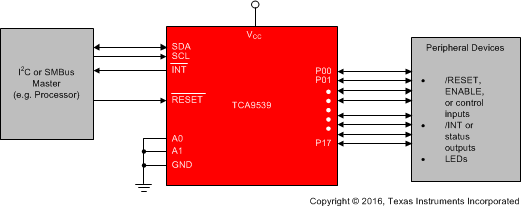SCPS202C October 2009 – May 2016 TCA9539
PRODUCTION DATA.
- 1 Features
- 2 Applications
- 3 Description
- 4 Revision History
- 5 Pin Configuration and Functions
- 6 Specifications
- 7 Parameter Measurement Information
- 8 Detailed Description
- 9 Application and Implementation
- 10Power Supply Recommendations
- 11Layout
- 12Device and Documentation Support
- 13Mechanical, Packaging, and Orderable Information
1 Features
- I2C to Parallel Port Expander
- Low Standby-Current Consumption
- Open-Drain Active-Low Interrupt Output
- Active-Low Reset Input
- 5-V Tolerant I/O Ports
- Compatible With Most Microcontrollers
- 400-kHz Fast I2C Bus
- Input and Output Configuration Register
- Polarity Inversion Register
- Internal Power-on Reset
- No Glitch on Power Up
- Noise Filter on SCL and SDA Inputs
- Address by Two Hardware Address Pins for Use of up to Four Devices
- Latched Outputs With High-Current Drive Capability for Directly Driving LEDs
- Latch-Up Performance Exceeds 100 mA Per JESD 78, Class II
- ESD Protection Exceeds JESD 22
- 2000-V Human-Body Model (A114-A)
- 1000-V Charged-Device Model (C101)
2 Applications
- Servers
- Routers (Telecom Switching Equipment)
- Personal Computers, smartphones
- Industrial Automation
- I2C GPIO Expansion
3 Description
The TCA9539 is a 24-pin device that provides 16 bits of general purpose parallel input and output (I/O) expansion for the two-line bidirectional I2C bus (or SMBus protocol). The device can operate with a power supply voltage (VCC) range from 1.65 V to 5.5 V. The device supports 100-kHz (I2C Standard mode) and 400-kHz (I2C Fast mode) clock frequencies. I/O expanders such as the TCA9539 provide a simple solution when additional I/Os are needed for switches, sensors, push-buttons, LEDs, fans, and other similar devices.
The features of the TCA9539 include an interrupt that is generated on the INT pin whenever an input port changes state. The A0 and A1 hardware selectable address pins allow up to four TCA9539 devices on the same I2C bus. The device can be reset to its default state by cycling the power supply and causing a power-on-reset. Also, the TCA9539 has a hardware RESET pin that can be used to reset the device to its default state.
Device Information(1)
| PART NUMBER | PACKAGE | BODY SIZE (NOM) |
|---|---|---|
| TCA9539 | TSSOP (24) | 7.80 mm × 4.40 mm |
| WQFN (24) | 4.00 mm × 4.00 mm | |
| VQFN (24) | 4.00 mm × 4.00 mm |
- For all available packages, see the orderable addendum at the end of the data sheet.
Simplified Schematic
